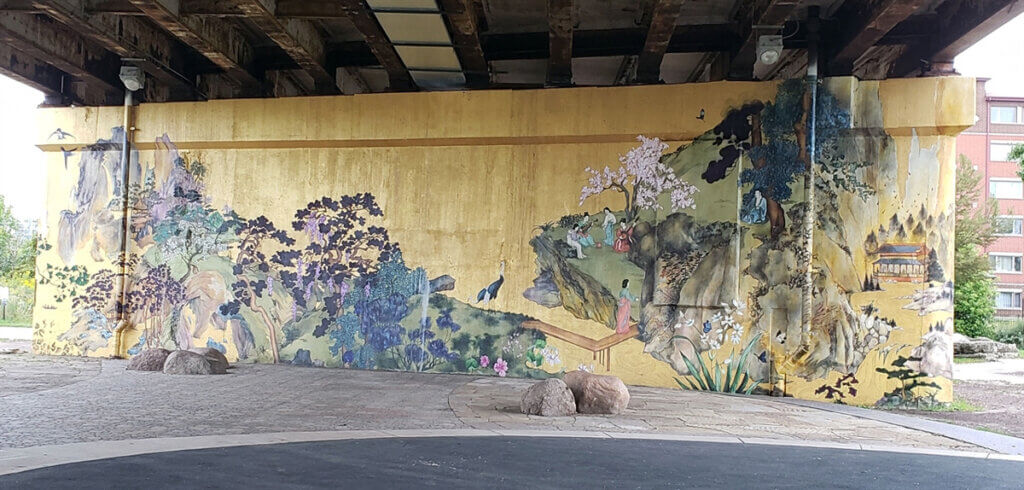Activation, construction and more. An update on riverfront projects!
The Chicago Community Trust is currently funding 11 community-led riverfront projects through their Our Great Rivers grant. This piece is the third in our 2019 series highlighting these projects.

This has been a transformative year for community implementation of projects that advance the Our Great Rivers vision. Through the Chicago Community Trust’s grant program, 11 organizations and their partners have been activating, programming, and constructing new projects in communities along the city’s rivers in 2019.
Their progress has been impressive, as we’ve already introduced you to a number of new projects that received funding this year, including: highlighting a water trail along the Little Calumet, and new sensors evaluating water quality of the Chicago River, as well as telling an exciting year two story about the continued activation of the Major Taylor Trail, but there’s much more happening.
Here’s all the successes and progress projects have made with their since the first year of funding:
Calumet Connect – Collaboration to plan for improvements along the Calumet River
Led by the Alliance for the Great Lakes, this project brought together Calumet area stakeholders to develop partnerships and agendas based on a shared set of values. Collaboration is never easy, but partners in the Calumet Connect were able to reach true consensus and goal alignment on research objectives to inform the creation of a data book to help facilitate land use planning for the Calumet Area Industrial Corridor.
LVEJO and NRDC: Moving public health concerns to the forefront of policy decisions
The Little Village Environmental Justice Organization (LVEJO) and the NRDC have had initial success integrating public health into the new mayor’s agenda as well as continuing to inform planning in the Little Village industrial area. Notable accomplishments for this year include the City’s Dept. of Public Health making a commitment to integrate cumulative impacts on public health into its work as well as incorporating environmental justice into Mayor Lightfoot’s transition team recommendations.
Northwest Portage Walking Museum: Connecting the Chicago and Des Plaines Rivers
On Indigenous People’s Day in mid-October, there will be an all-day event at Schiller Woods celebrating the finished construction of an Indian effigy mound, the first to be created by an indigenous artist since the establishment of the United States. This is just the first of two mounds that will be constructed, with the second one still in process for Horner Park. This project, as well as the artist Santiago X, was featured as part of the Chicago Architecture Biennial.
Chinatown Wayfinding and Activation: Enhancing community and connections to the riverfront
Chinatown’s second riverfront mural was unveiled at the Chicago River Revival Festival on September 7. The mural’s design was reached by consensus through participatory meetings on mural design and as well as hosting a community wide tracing event, prior to completion of the art work. The mural is entitled Between the Mountains and the Water and took inspiration from Chinese scrolls.
Heartland Housing: Helping residents connect with their rivers through activation and programming
Working as part of Lathrop Community Partners, Heartland Housing hosted a series of community and neighbor night events with Lathrop residents to get them to be more comfortable around the water and water-based recreation. These events have featured kayak paddles with Friends of the Chicago River as well as other activities. A ribbon cutting in October will commemorate the rejuvenation of the riverfront landscape complete with a trail and boat launch adjacent to the river.
Better Beaubien: Creating new community connections to the Little Calumet River in Beaubien Woods
The Forest Preserves of Cook County (FPCC) are learning more about the community assets of the Riverdale/Altgeld/Golden Gate community and how to align resources. They have discovered possibilities with the parks, the library, local non for profits, schools, Metropolitan Family Services, and with the Chicago Housing Authority, spending time as being part of collation and planning meetings. These meetings have helped them understand the need or the opportunity of the members, to help solve bigger issues. For example when we understood the Chicago Housing Authority was interested in assisting seniors with flower plantings, FPCC asked to be involved to provide and support the planting of native plants that are beneficial for pollinators. As a result, FPCC along with the Field Museum were able to provide more than 60 seniors with plantings and information about native plants and pollinators. In addition there have been opportunities to partner around job creation for young people in the summer and develop programs and trainings for teachers and students in the local schools. As these relationships grow, FPCC will also establish a more robust wayfinding system at Beaubien and develop a space to store recreation and restoration equipment for community use.
South Branch Park Advisory Council: South Branch Parks Framework Plan
The South Branch Park Advisory Council (SB PAC) released its Framework Plan for improving connections between Park 571 and Eleanor Boathouse, Canal Origins Park, and Canalport Riverwalk in early 2019. Since then, the organization has partnered with CDOT and received funding through the State Planning & Research grant to study the feasibility of pedestrian bridge connections where Bubbly Creek and the South Branch of the Chicago River meet.
Our Great Rivers / Great Rivers Chicago: MPC’s Blogs and highlights on Our Great Rivers are made possible in large part by the Chicago Community Trust, the Richard H. Driehaus Foundation, the Charles Stewart Mott Foundation, the Joyce Foundation, the Union Pacific Foundation, BNSF Corporation, Gaylord & Dorothy Donnelley Foundation, the John D. and Catherine T. MacArthur Foundation ArcellorMittal, Comcast Corporation, and individual donors.
